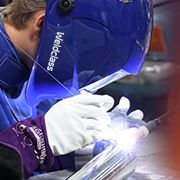The MMA "Stick" Welding Process - your questions answered

What is MMA Welding?
The acronym MMA (or MMAW) stands for Manual Metal Arc Welding. ‘Manual’ refers to the fact that the MMA process requires the operator to apply filler metal (in contrast to MIG ‘semi-automatic’ welding where the machine feeds the filler metal into the weld). ‘Metal’ refers to the fact that the filler metal itself (the stick electrode) is used to conduct the welding current to the job. MMA welding is commonly known as ‘stick-electrode’ or ‘arc’ welding.
The MMA process involves the electrode being touched on the job to ignite the arc. The electrode is held in the electrode holder and must be continually replaced as it is consumed. The electrode consists of a metal core, which is the filler metal, covered by a flux coating which shields the weld and prevents it from oxidising. During welding the flux forms into a slag coving the weld which is chipped off after the weld has formed.
What are the Advantages of MMA Stick Welding?
MMA welding offers several advantages over alternative welding processes. Primarily it has a greater capacity than MIG welding, or in other words it can weld heavier materials with the same amperage output. For this reason small, portable MMA stick inverter welders like the amazingly compact FORCE 135ST, have the capacity to weld with up to 4mm electrodes, making them suitable for a vast range of applications and material thicknesses without the complication of shielding gas or wire feeding.
Thanks to inverter technology, MMA is also a highly portable process and is often used for site and field work.
Also, MMA welding is typically more ‘forgiving’ than MIG or TIG when welding rusty or dirty materials, which makes it ideal for maintenance applications.
What are the Disadvantages of MMA Stick Welding?
Welding thin materials whilst avoiding “blow-through” can be tricky with the MMA process. This is easier with inverter welding machines like the Weldforce range from Weldclass because the arc is so stable and the output can be very finely adjusted.
MMA/Stick welding is slower than MIG welding, due to the need to replace electrodes and chip slag. For this reason, MIG is a more popular choice for production work.
What is the correct Polarity when MMA/Stick welding?
Polarity refers to the direction of current flow when welding.
Some electrodes types and brands may operate best on DC+ polarity, others are better run on DC-, and many electrodes run either way with very little difference. Polarity is typically less critical when stick welding.
DC+ (also known as; DCEP, or direct current electrode positive)
Work lead connected to the positive (+) terminal
Earth lead connected to the negative (-) terminal
This typically results in deeper weld penetration, with more "heat" directed into the job.
DC- (also known as; DCEN, or direct current electrode negative)
Work lead connected to the negative (-) terminal
Earth lead connected to the positive (+) terminal
This typically results in faster deposition rate (melt-off), with more "heat" directed to the electrode.

It is recommended to check the manufacturer’s instructions or experiment on scrap metal to find the ideal polarity for each type of electrode and application.
Material Thickness vs Electrode Size vs Amps
Because of the many variables in any given application, there is no single formula to say "for X thickness you need X amps". The factors that influence this are;
Type of electrode/rod
Type of weld joint: Corner, butt, is the joined bevelled or square, etc
Weld position: Flat, vertical, overhead, etc
Technique: Single or multi-pass, joint one side or both sides, etc
Required strength of the weld joint (which will influence whether less or more penetration is acceptable)
Etc
However, here's a rough guide for welding of mild steel
Assuming:
Single sided butt joint, with a single weld pass.
Using general-purpose (6013 series) or low-hydrogen (7016 & 7018 series) electrodes.
Rule-of-thumb:
For approx' 2mm to 6mm material, chose a welding rod size (diameter) that is one step down from the material thickness.
You can typically use a rod diameter down to half the thickness of the base metal with good results. If the rod is smaller than that, you may still be able to weld it, but the penetration may be less than satisfactory.
|
Steel |
Suggested |
Amps |
|
1-2mm |
1.6-2.0mm |
40-60A |
|
2-4mm |
2.5/2.6mm |
60-110A |
|
4-6mm |
3.2mm |
90-140A |
|
5-10mm |
4.0mm |
130-190A |
More articles on MMA / Stick Welding
What is Hot Start, Arc Force & Anti-Stick?
What is Open Circuit Voltage (OCV) ?
Using Generators to power Inverter Welders
Welding electrode drying ovens
The benefits of twin-coated electrodes
Why you will never get a good weld with a bad earth clamp
While all care has been taken, Weldclass accepts no responsibility for any inaccuracies, errors or omissions in this information or links and attachments. Any comments, suggestions & recommendations are of a general nature only and may not apply to certain applications. It is the sole responsibility of the user and/or operator to select the appropriate product for their intended purpose and to ensure that the product selected is capable of performing correctly and safely in the intended application. E.&O.E.



